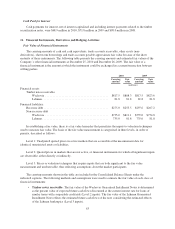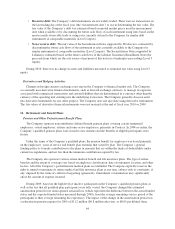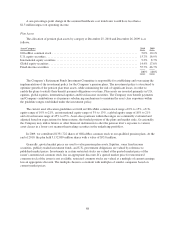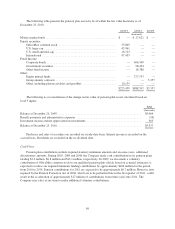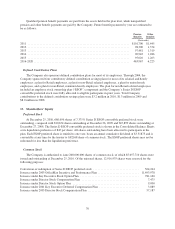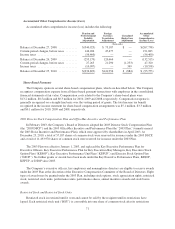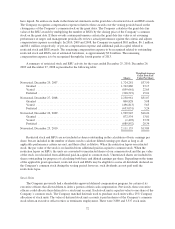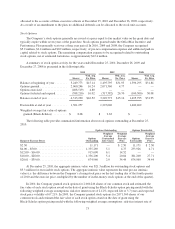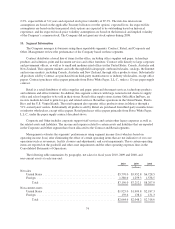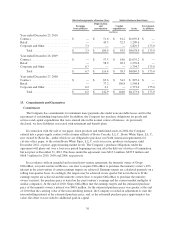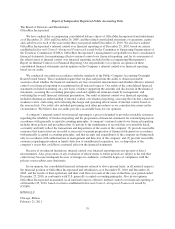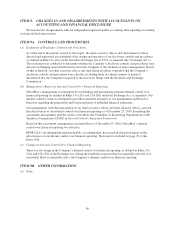OfficeMax 2010 Annual Report Download - page 92
Download and view the complete annual report
Please find page 92 of the 2010 OfficeMax annual report below. You can navigate through the pages in the report by either clicking on the pages listed below, or by using the keyword search tool below to find specific information within the annual report.
have lapsed. No entries are made in the financial statements on the grant date of restricted stock and RSU awards.
The Company recognizes compensation expense related to these awards over the vesting periods based on the
closing price of the Company’s common stock on the grant dates. The Company calculates the grant date fair
value of the RSU awards by multiplying the number of RSUs by the closing price of the Company’s common
stock on the grant date. If these awards contain performance criteria the grant date fair value is set assuming
performance at target, and management periodically reviews actual performance against the criteria and adjusts
compensation expense accordingly. In 2010, 2009 and 2008, the Company recognized $8.0 million, $6.1 million
and $0.1 million, respectively, of pre-tax compensation expense and additional paid-in capital related to
restricted stock and RSU awards. The remaining compensation expense to be recognized related to outstanding
restricted stock and RSUs, net of estimated forfeitures, is approximately $9.8 million. The remaining
compensation expense is to be recognized through the fourth quarter of 2013.
A summary of restricted stock and RSU activity for the years ended December 25, 2010, December 26,
2009 and December 27, 2008 is presented in the following table:
Shares
Weighted-Average
Grant Date Fair
Value Per Share
Nonvested, December 29, 2007 ......................................... 1,724,281 $37.50
Granted ....................................................... 1,742,860 23.17
Vested ........................................................ (859,661) 22.65
Forfeited ....................................................... (348,519) 15.01
Nonvested, December 27, 2008 ......................................... 2,258,961 $31.07
Granted ....................................................... 800,828 5.08
Vested ........................................................ (496,813) 5.65
Forfeited ....................................................... (633,031) 5.24
Nonvested, December 26, 2009 ......................................... 1,929,945 $16.24
Granted ....................................................... 872,534 13.81
Vested ........................................................ (1,492) 33.70
Forfeited ....................................................... (689,852) 20.34
Nonvested, December 25, 2010 ......................................... 2,111,135 $13.89
Restricted stock and RSUs are not included as shares outstanding in the calculation of basic earnings per
share, but are included in the number of shares used to calculate diluted earnings per share as long as all
applicable performance criteria are met, and their effect is dilutive. When the restriction lapses on restricted
stock, the par value of the stock is reclassified from additional paid-in-capital to common stock. When the
restriction lapses on RSUs, the units are converted to unrestricted shares of our common stock and the par value
of the stock is reclassified from additional paid-in-capital to common stock. Unrestricted shares are included in
shares outstanding for purposes of calculating both basic and diluted earnings per share. Depending on the terms
of the applicable grant agreement, restricted stock and RSUs may be eligible to accrue all dividends declared on
the Company’s common stock during the vesting period; however, such dividends are not paid until the
restrictions lapse.
Stock Units
The Company previously had a shareholder approved deferred compensation program for certain of its
executive officers that allowed them to defer a portion of their cash compensation. Previously, these executive
officers could allocate their deferrals to a stock unit account. Each stock unit is equal in value to one share of the
Company’s common stock. The Company matched deferrals used to purchase stock units with a 25% Company
allocation of stock units. The value of deferred stock unit accounts is paid in shares of the Company’s common
stock when an executive officer retires or terminates employment. There were 3,889 and 5,337 stock units
72



